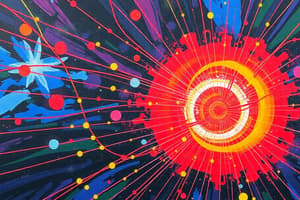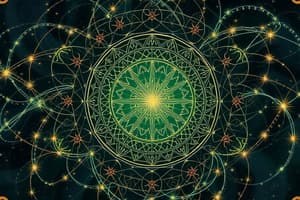Podcast
Questions and Answers
What type of materials become magnetic when moved back and forth really fast along the lines of strength in a strong magnetic field?
What type of materials become magnetic when moved back and forth really fast along the lines of strength in a strong magnetic field?
Only certain materials
Why do magnetic forces work best when there is something to push against?
Why do magnetic forces work best when there is something to push against?
To have a force to push or pull against
Explain the process of magnetic induction.
Explain the process of magnetic induction.
Using coils of wire wrapped around magnets to create artificial magnets
What is the concept of electromagnetism?
What is the concept of electromagnetism?
Which materials, when moved back and forth in a strong magnetic field, do not become magnets even at high speeds?
Which materials, when moved back and forth in a strong magnetic field, do not become magnets even at high speeds?
What creates a magnetic field in magnets?
What creates a magnetic field in magnets?
Describe the patterns formed by magnetic field lines around a magnet.
Describe the patterns formed by magnetic field lines around a magnet.
What are the two main types of forces caused by magnets?
What are the two main types of forces caused by magnets?
Explain the behavior when two bar magnets with opposite poles are brought close together.
Explain the behavior when two bar magnets with opposite poles are brought close together.
How does the strength of a magnetic field relate to the size of a magnet?
How does the strength of a magnetic field relate to the size of a magnet?
Flashcards are hidden until you start studying
Study Notes
Magnetic Effects Overview
Magnetic effects refer to phenomena related to magnetism, which is a fundamental property of matter arising from its interaction with electric currents. Magnets possess this ability because they have tiny particles, called atoms, spinning around like a whirlwind inside them, each carrying their own little charge, causing electricity to flow through the entire thing. This flow creates a magnetic field, meaning it strongly attracts other magnets made out of iron.
There are several aspects of magnetic effects to consider when exploring magnetism further:
Magnetic Field
The first characteristic of magnetism is the magnetic field itself, which we call a bunch of invisible lines running all around any real magnet, making patterns that show exactly where the strongest pull of the magnet comes from. They can also wrap themselves into shapes like rings or twisty coils, pulling in different directions depending on how the loops were drawn up in the first place. Stronger magnets make stronger fields, just like bigger rivers produce more powerful tides.
Magnetic Force
Forces caused by magnets come in two main types — push forces called repulsion and pull forces called attraction. When you put one end of a bar magnet close to another, the north part will start pushing away while the south part starts pulling towards it. If both ends are the same (north on top), then there'll be a big push between the feet and a smaller push above it. But if they're opposite (say south on bottom), there won't be any pushes at all! So, magnetic forces work best when they've got something to push against.
Magnetic Materials
Materials become magnetic when they get moved back and forth really fast along the lines of strength in a strong magnetic field created by putting wires looped together. Only certain ones do though; those made mostly with heavy elements like aluminum or copper don't turn into magnets even when they go superfast, but if iron does it instead, then it becomes attracted to regular magnets too!. There must always be some room in between whatever bits want to move apart, otherwise normal sparks would fly off. Other metals besides iron can be used too; cobalt and nickel also easily take on magnetic properties under extreme conditions.
Electromagnetism
Electromagnetism combines electrical charges moving near strong magnets into what we call an electromagnetic wave. These waves carry energy from point A to B much faster than light does over airwaves - upwards of millions times speedier! They travel especially well across space and water since nothing gets in their way. With these high speeds come some limitations; once an electromagnetic wave reaches the moon or Mars, its journey slows right down again until eventually stopping completely after bouncing past Jupiter. In order for it to keep going forever, there has to be somewhere new where electricity can escape - either onto another planet or back home earthward.
Magnetic Induction
Finally, magnetic induction involves using coils of wire wrapped around magnets so tightly that every single bit of electricity flowing through them makes more permanent magnets by squeezing bits into special places. This method allows us to create artificial magnets, such as the kind found on refrigerators, allowing us to generate our own magnetic fields without needing a natural source like Earth.
In summary, understanding the magnetic effects discussed here helps illuminate various aspects of magnetism, ranging from the behavior of magnetic fields and forces to the types of materials capable of becoming magnetic, the concept of electromagnetism and finally, methods for generating artificial magnets.
Studying That Suits You
Use AI to generate personalized quizzes and flashcards to suit your learning preferences.




